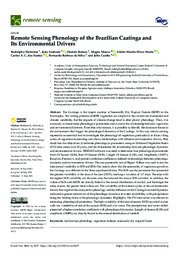Remote sensing phenology of the brazilian Caatinga and its environmental drivers.
Remote sensing phenology of the brazilian Caatinga and its environmental drivers.
Author(s): MEDEIROS, R.; ANDRADE, J.; RAMOS, D.; MOURA, M. S. B. de; PÉREZ-MARIN, a. m.; SANTOS, C. A. C. dos; SILVA, B. B. da; CUNGA, J.
Summary: The Caatinga is the largest nucleus of Seasonally Dry Tropical Forests (SDTF) in the Neotropics. The leafing patterns of SDTF vegetation are adapted to the current environmental and climate variability, but the impacts of climate change tend to alter plants? phenology. Thus, it is necessary to characterise phenological parameters and evaluate the relationship between vegetation and environmental drivers. From this information, it is possible to identify the dominant forces in the environment that trigger the phenological dynamics of the Caatinga. In this way, remote sensing represents an essential tool to investigate the phenology of vegetation, particularly as it has a long series of vegetation monitoring and allows relationships with different environmental drivers. This study has two objectives: (i) estimate phenological parameters using an Enhanced Vegetation Index (EVI) time-series over 20 years, and (ii) characterise the relationship between phenologic dynamics and environmental drivers. TIMESAT software was used to determine four phenological parameters: Start Of Season (SOS), End Of Season (EOS), Length Of Season (LOS), and Amplitude (AMPL). Boxplots, Pearson?s, and partial correlation coefficients defined relationships between phenologic dynamics and environmental drivers. The non-parametric test of Fligner Killeen was used to test the interannual variability in SOS and EOS. Our results show that the seasonality of vegetation growth in the Caatinga was different in the three experimental sites. The SOS was the parameter that presented the greatest variability in the days of the year (DOY), reaching a variation of 117 days. The sites with the highest SOS variability are the same ones that showed the lowest EOS variation. In addition, the values of LOS and AMPL are directly linked to the annual distribution of rainfall, and the longer the rainy season, the greater their values are. The variability of the natural cycles of the environmental drivers that regulate the ecosystem?s phenology and the influence on the Caatinga?s natural dynamics indicated a greater sensitivity of the phenologic dynamics to water availability, with precipitation being the limiting factor of the phenologic dynamics. Highlights: The EVI time series was efficient in estimating phenological parameters. The high variability of the start of season (SOS) occurred in sites with low variability of end of the season (EOS) and vice versa. The precipitation and water deficit presented a higher correlation coefficient with phenological dynamics. Length of Season (LOS) and amplitude (AMPL) are directly linked to the annual distribution of rainfall. View Full-Text
Publication year: 2022
Types of publication: Journal article
Unit: Embrapa Semi-arid Region
Observation
Some of Embrapa's publications are published as ePub files. To read them, use or download one of the following free software options to your computer or mobile device. Android: Google Play Books; IOS: iBooks; Windows and Linux: Calibre.
Access other publications
Access the Agricultural Research Database (BDPA) to consult Embrapa's full library collection and records.
Visit Embrapa Bookstore to purchase books and other publications sold by Embrapa.

